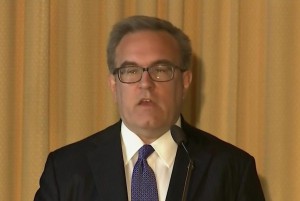
EPA Administrator Andrew Wheeler argues that the CAFE changes are getting cleaner, safer cars onto the road faster than under the Obama rules.
The Trump administration is arguing that its deregulation polices are helping reduce the amount of heat-trapping carbon dioxide emitted by automobiles.
In a report issued this week, Trump’s EPA said auto manufacturers continue increasing fuel economy and reducing pollution through innovation.
Andrew Wheeler, the new head of the EPA, said the latest edition of U.S. Environmental Protection Agency’s annual Automotive Trends Report underscores the administration’s contention.
“Today’s report shows that while the auto industry continues to increase fuel economy, there are legitimate concerns about the ability to cost-effectively achieve the Obama Administration’s standards in the near future,” Wheeler said.
(Honda leads the pack in fuel economy average. Click Here for the story.)
“EPA and DOT will have those concerns in mind as we move forward with our Safe Affordable Fuel Efficient Vehicles rule, which would allow the industry to meet aggressive yet attainable standards, reduce the price of new vehicles, and help more Americans purchase cleaner, safer, and more efficient vehicles,” added Wheeler, replacement for the scandal-tarred Scott Pruitt.
Back in January, the EPA listed a drop in greenhouse gas emissions as part of its list of 2018 achievements.
The EPA’s annual review highlighted regulatory reform, a reduction in air pollution, deletion of Superfund sites and sizable grant funding numbers as some of the major accomplishments it achieved in a year.
“Over the past year, the Trump Administration has continued to deliver on its promises to the American public. Not only are the economic prospects of Americans brighter and improving by the day, but so are environmental and public health conditions. Under President Trump, America is on a path to a stronger, safer, and cleaner future,” Wheeler said in a statement.
The Trump administration has proposed freezing the fuel-economy and emission standards at the level proposed for the 2021 model. The Trump freeze would roll back the standards put in place during the closing days of the Obama administration, which call on manufacturers to produce a fleet-wide average of 50 miles per gallon by 2026.
(Click Here to see why oil-rich Norway is the land of the electric vehicle.)
The standard requires a heavy commitment to electric vehicles and is being championed by the State of California, the nation’s largest market for new vehicles, which has had the statutory right to set its emission standards for automobiles for more than half a century.
Last month, the Trump administration broke off negotiations with the State of California, setting the stage for a potential legal clash likely to influence automotive engineering and design for decades to come.
While California’s right to set standards has a long history and has survived challenges in the past, the Trump administration believes it has the votes on the U.S. Supreme Court to force the State of California to loosen its tough standards.
Another potential outcome is a split decision with no clear-cut mandate that leads to more litigation and uncertainty for camakers and suppliers, who have billions of dollars at stake.
(Green Car finalists revealed. Click Here for the story.)
Meanwhile, fuel economy for the U.S. fleet continues to improve under the standards supported by the Obama administration and California, EPA reported. Model Year 2017 vehicle fuel economy was 24.9 miles per gallon, slightly higher than MY 2016, and a record high overall. Since MY 2004, fuel economy and carbon dioxide emissions have improved in 11 out of 13 years, EPA said in its new report.
